
Somewhere between Poland and Ukraine, amid the lush, sprawling dominion of wild marshlands and ancient birch trees that majestically reach up the mountain, our team, consisting of a journalist, a photographer, and two scientists, is walking through the Ukrainian part of the Roztochia Biosphere Reserve. In the serenity of uncultivated nature, it's impossible not to notice how the forest changes, and with it, the smells and the temperature: from the warm autumn, fragrant smell of leaves and mushrooms to the colder smell of wet bark that is characteristic of beech forests.
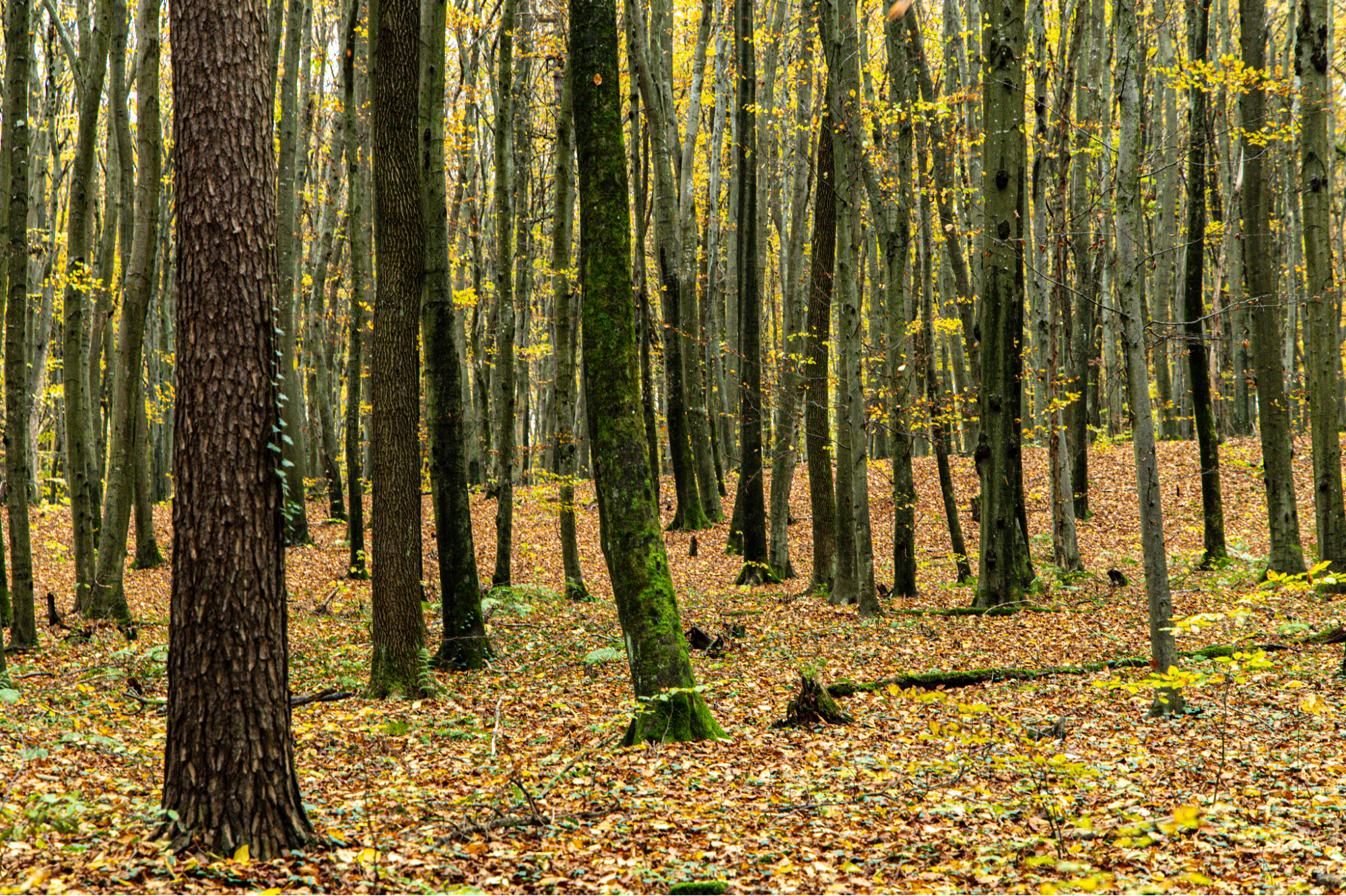
Untouched beech forests grow in the core zone of the biosphere reserve Roztochia. Photo: Mykola Tymchenko for Rubryka
As we approach the place where only beeches grow, it becomes darker and cooler, and the surrounding forest takes on a mysterious and mystical atmosphere.
We are in the core zone of the Roztochia reserve. On the way, between the giant trees, Halyna Stryamets, deputy director for scientific work, explains why protecting such areas is essential. She explains the beech forest can never be restored if it disappears. The trees surrounding us are 200 years old, and we had a unique opportunity to capture places where only a small circle of specialists is allowed to be.
On the territory of the reserve, even despite the war, research continues; the forest is regularly examined by inspectors, and scientists are engaged in restoration activities. Before this area became a protected nature reserve, its territory contained a swamp drained during Soviet times. However, this marsh is now being restored.A few years ago, Ukrainian scientists and German colleagues built log cabins, and after that, nature helped to restore the marsh.

Photo: Mykola Tymchenko for Rubryka
Stryamets jokes that scientists are restoring the swamps together with beavers. Animals help build dams —sometimes, where they should be, sometimes not, and they must be destroyed.
The matter has not yet fully recovered because it is a multi-year process. So far, vegetation is slowly recovering in the swamps – but in the future, after many decades, the area will again take on the appearance it had in ancient times.
The reserve itself is quiet, and the only sounds that can be heard are the rustling of leaves and the singing of birds that have not yet flown away. Nothing is reminiscent of the war in Ukraine, but not all parts of Roztochia are as peaceful.

Swamps on the territory of the reserve are gradually recovering. Photo: Mykola Tymchenko for Rubryka
What is the problem?
Constant explosions in the deep rear, low salaries, and the inability to compete
Although the Yavoriv National Nature Park, which is also part of the Roztochia biosphere reserve, is located deep in the rear, two of its recreational areas are actually in the buffer zone of the Yavoriv military base. Therefore, nearby recreations area used for holiday retreats, eco-educational center, and lakes are currently closed to tourists. Although the zone is still partially open to visitors, the human factor comes into play — few people are willing to admire nature where there are explosions and the danger of an enemy attack.

Photo: Mykola Tymchenko for Rubryka
Due to the decrease in tourists, the park has lost about 90% of its income. With these funds, the park administration used to buy fuel and cover the institution's expenses. Now, it is only able to preserve the core team, which is decreasing because of low employee wages. This is the main influence of the war on the institution.
About 80% of workers earn minimum wages, which is less than €200 monthly. The national park does not have funds for any additional expenditures. With the beginning of the war, personnel began leaving to relocate, adding the challenge to replace employees with new ones. The national park director explains it as follows: many new enterprises have come to the region, and the park cannot be a competitor among other employers.
What are the solutions?
Of course, to stop the constant threat of shelling, return tourists, and open the closed areas to make profits, there is only one solution — to end the war. But there is one way to protect people, help them survive the war, and save them by finding solutions to not-so-obvious challenges.
Friendship with the Polish part of the reserve
Nature knows no political borders – and since the biosphere reserve spans across both Polish and Ukrainian land, the two sides coordinate closely. Friendly partnership relations between the parks have lasted for more than 20 years, and the reserve itself appeared on Ukrainian territory with the help of scientists from the Polish park.
The war in Ukraine indirectly affected Poland as well —it was the first to accept Ukrainian refugees, most of whom are likely to remain until hostilities have ended. Poland has helped Ukrainians at so many levels, and the Polish park Roztochia, which is also part of the reserve, is also a part of the process.

Eco-trail through swamps in Roztochia. Photo: Mykola Tymchenko for Rubryka
When full-scale war broke out, Polish parks announced a collection of humanitarian aid, and once every two weeks, tourist buses brought medical supplies and other essentials. Employees of the Ukrainian park received and unloaded the cargo and then sent it on to the front. The buses did not return empty, shuttling Ukrainian refugees to safety in Polish cities.
However, the cooperation of the park is not limited to this only — joint scientific research, bicycle paths connecting both parks and even the presence of horses which are not found anywhere else in the world, are the results of joint work of the Ukrainian and Polish biosphere parks.
Horses that are not left in the wild
Long before the creation of a nationally protected biosphere reserve, agriculture was actively developed in these territories. Fertile lands, a good climate, and people's hard work bore their fruits, but the farmers still had one enemy that trampled all the fields — tarpan horses. A subspecies of wild horses, tarpan horses are slightly smaller than modern horses, which are their genetic descendants.

Tarpan horses are an artificially restored species of horses that no longer exist in the wild. Photo: Mykola Tymchenko for Rubryka
Their population was once large, and tarpans lived throughout central Europe. However, horses interfered with local agriculture, and the species was nearly completely eliminated. At the end of the 19th century, scientists began to study the species, and by 1912, it was believed to be completely extinct.
Closer to the middle of the 20th century, in the Polish part of Białowieża Forest, Polish horses, which look almost like tarpans, were artificially restored through breeding by peasant farmers.
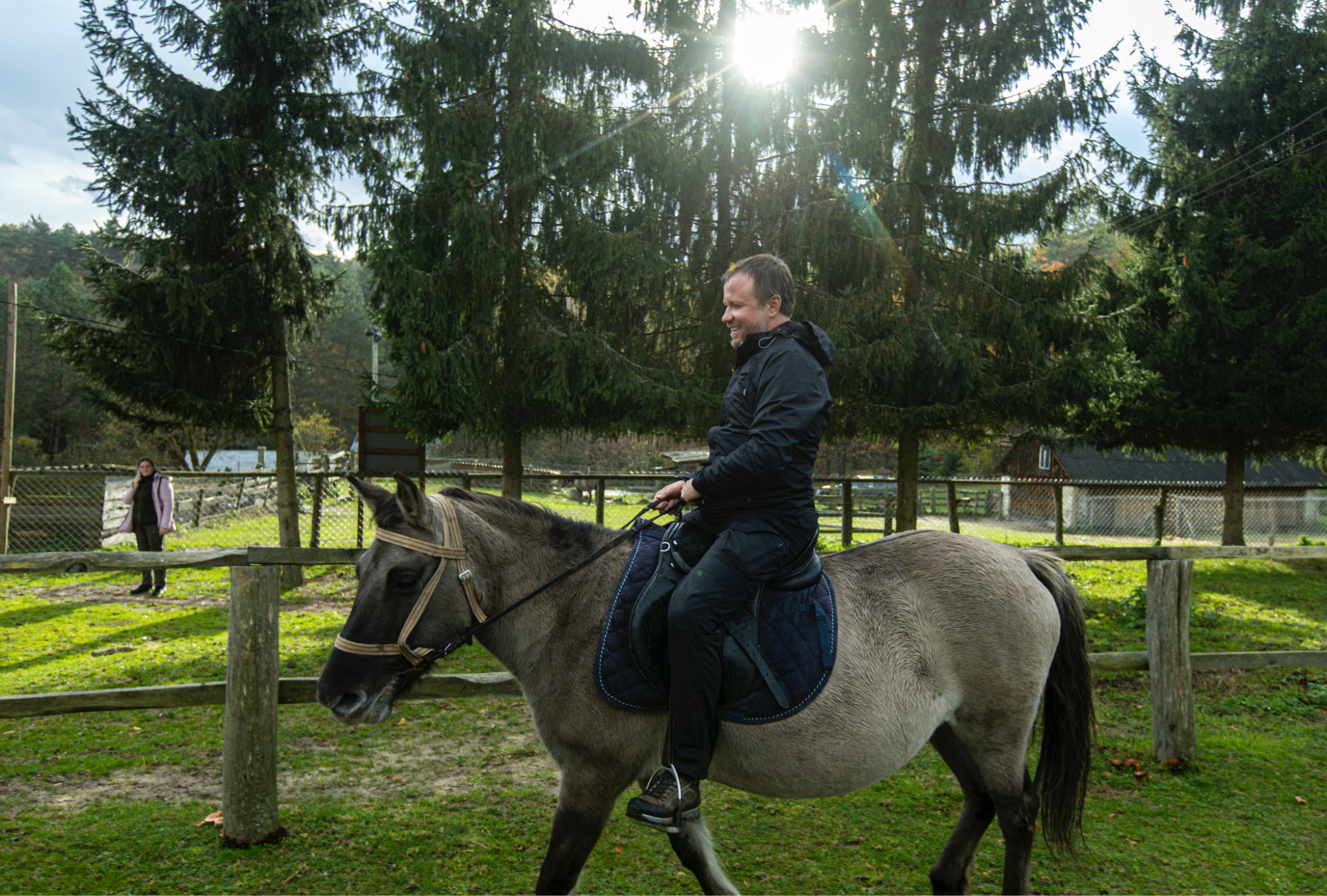
Rubryka photographer Mykola Tymchenko riding a tarpan horse. Horses are characterized by wild tempers, so it is not easy for even experienced riders. Photo: Victoria Gubareva for Rubryka
These horses now live in the Polish side of Roztochia. In 2009, Polish conservationists transferred several specimens to the Yavoriv Park in Ukraine, and now distant descendants of the once-extinct species also live here. If, from a biological point of view, modern tarpans have not inherited all the qualities of their ancestors – they have preserved their wild nature. Even experienced riders find it difficult to tame such an animal.
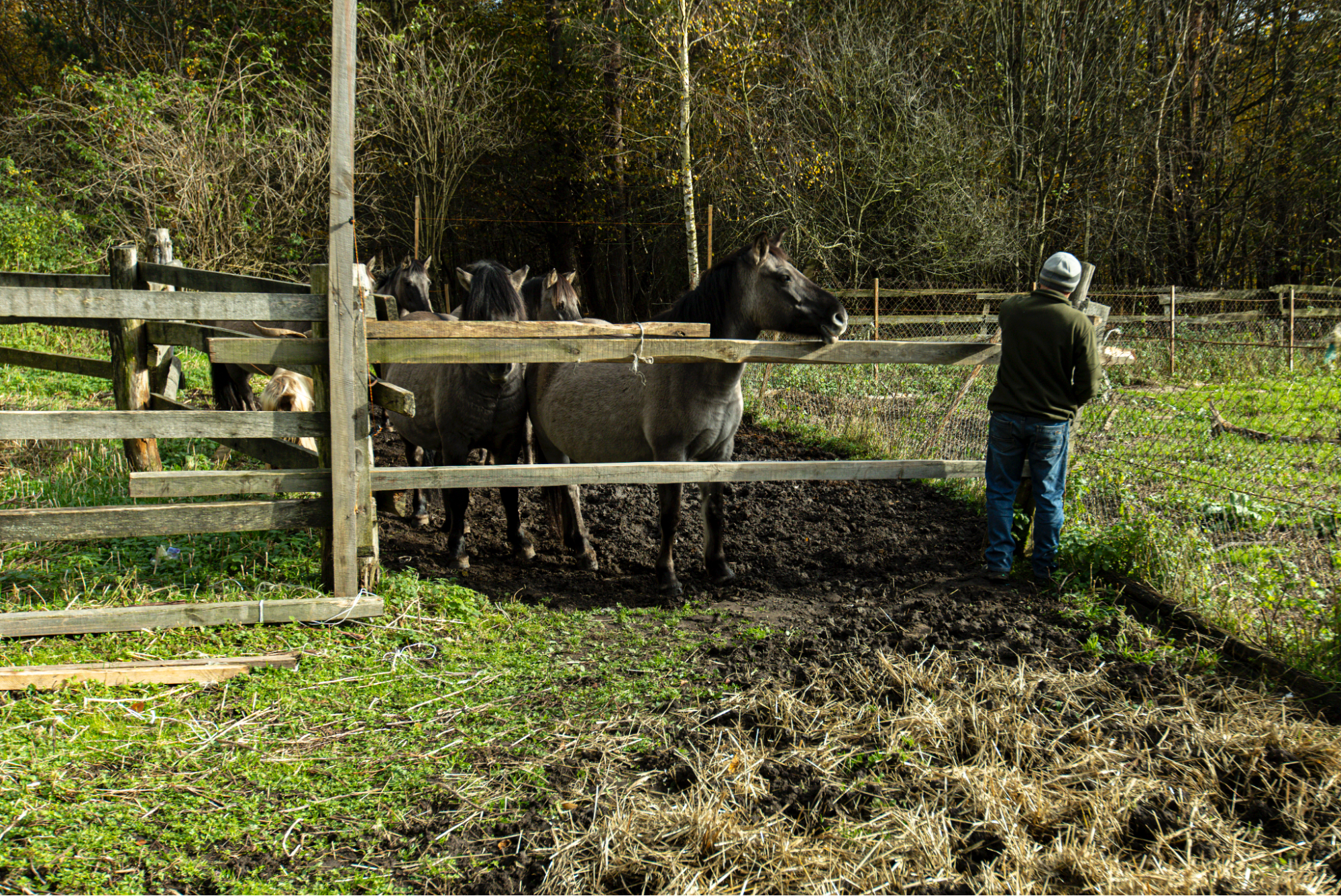
Tarpan horses in the Yavoriv National Park are kept in a pen. Releasing them into the wild is impossible — people have occupied large areas, leaving no space for tarpans. Photo: Mykola Tymchenko for Rubryka
The situation is not yet able to provide for the rewilding and release of tarpan offspring into the wild – even in captivity, one horse requires up to five hectares of land for grazing, ideally much more for a completely independent existence. Proximity to large settlements does not allow these horses to live independently, but because of their hardiness and smaller size, people still buy horses for farm use or tourist attractions.
"People like us can be born in 100 years"
На Яворівщині досі зберігаються традиційні промисли.
Traditional customs are still preserved in the Yavoriv region. Monks in the Krekhiv Monastery, located next to the National Park, live almost entirely on self-sustenance — they own a large apiary home to scores of honeybees, almost four dozen dairy cows, and several hectares of land. This is a typical local farm — such animal husbandry has been ongoing here since the 17th century.

In the Krekhiv monastery, the monks are engaged in natural crafts and almost completely provide themselves with products. Photo: Mykola Tymchenko for Rubryka
People living next to the reserve still cultivate the land on their own homesteads. However, the land in the territory is not very fertile, and agriculture has always been unprofitable. Instead, the abundance of forests allowed for the production of many wooden products for sale. Now, this trade has lost its popularity — woodworkers have been replaced by furniture factories nearby.
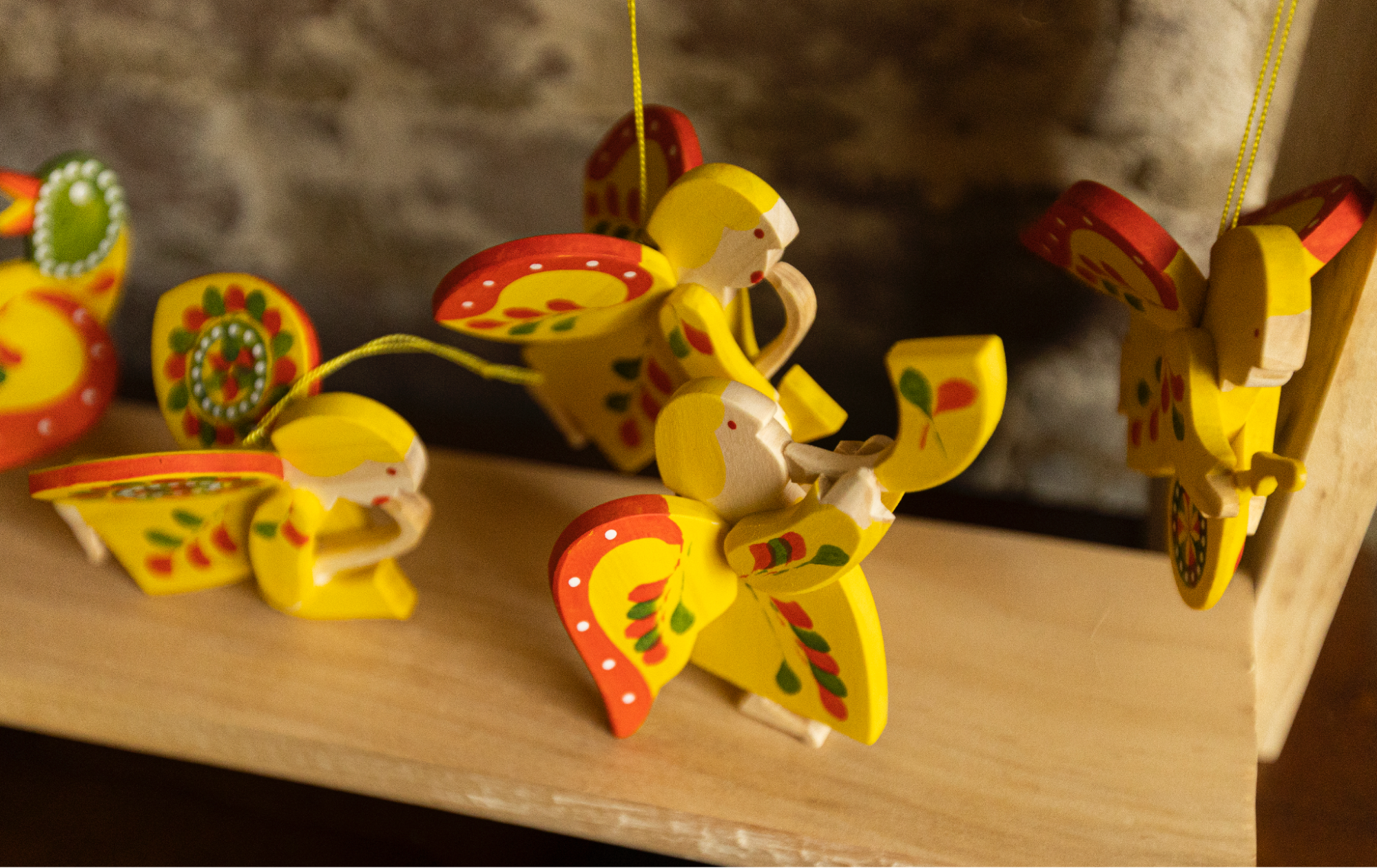
Traditional Yavoriv toys made by artist Oksana Kohut. She is one of several masters in Ukraine who is engaged in this craft. Photo: Mykola Tymchenko for Rubryka
However, the traditional Yavoriv painting remains a reminder of the past which has survived to our times, largely unchanged state – painting is taught at the local art college in Ivano-Frankivsk. Here, much more time is devoted to this craft than in other artistic institutions of education, but students say they are unlikely to work with this particular technique.

Students of art college in Ivano-Frankivsk. This college devotes the most study time to teaching children Yavoriv painting. Photo: Mykola Tymchenko for Rubryka
The craft is recognized as a cultural heritage of Ukraine — once upon a time, in almost every home, children played with Yavoriv toys — traditional toys originating from this region. The first mentions of Yavoriv toys date back to the testimonies of travelers in the 17th century, when toys traveled all over Ukraine. However, now, there is a craftswoman who makes traditional toys on a permanent basis.

Students study the history of Yavoriv painting and learn to carve and paint toys. This college is famous for its woodworkers. Photo: Mykola Tymchenko for Rubryka
"At that time, the fairs were lined with these toys, but with the arrival of the USSR in Ukraine, new models appeared – and besides, there was a ban on traditional products," Oksana Kohut, an artist who specializes in producing Yavoriv toys, tells us.
Kohut is so passionate about her work that you can get burned if you get too close. We were invited to her workshop, which the craftswoman set up in her own house.
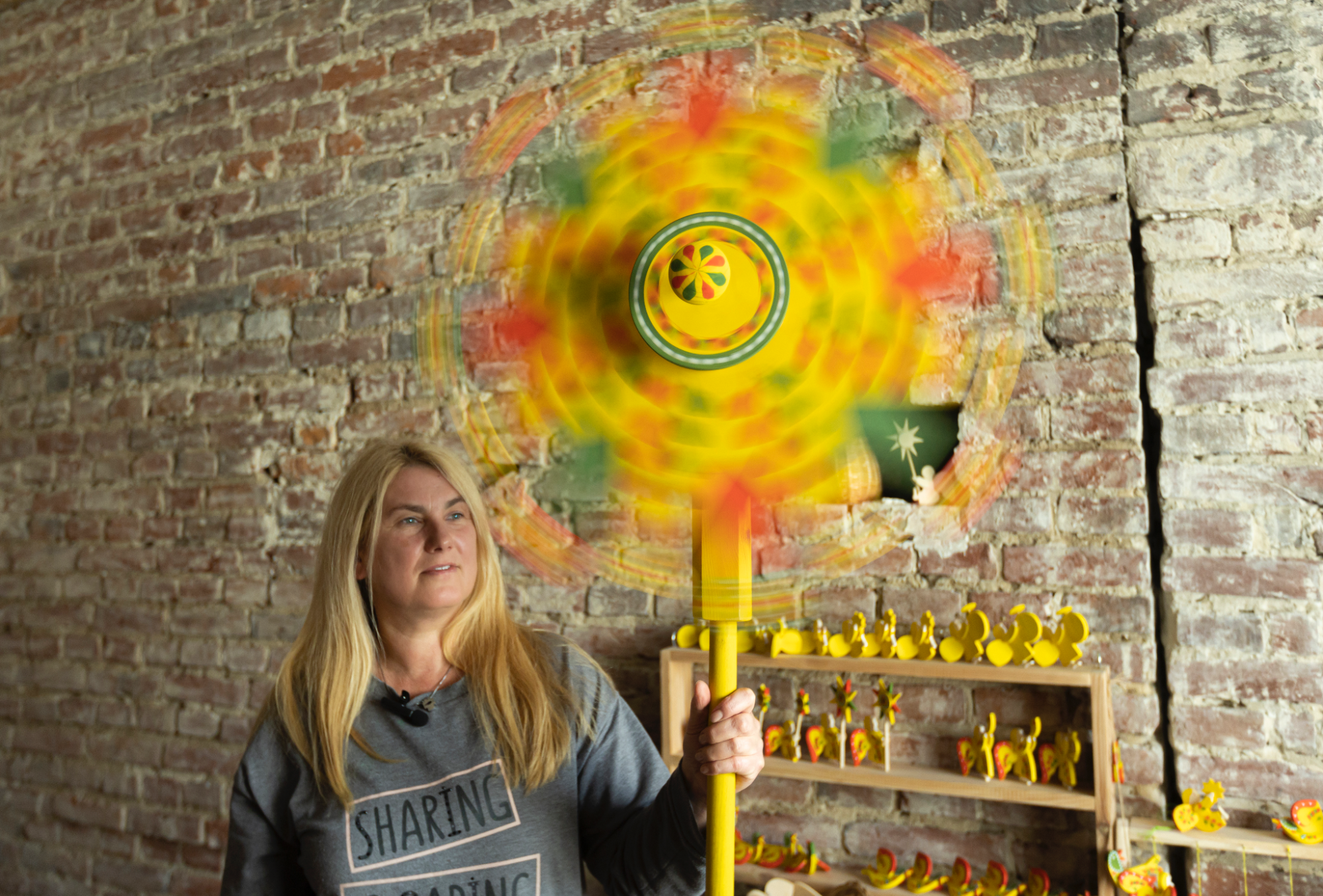
Oksana Kohut with the Star of Bethlehem. Her products travel worldwide, and her toys have featured on the Christmas tree in the Vatican. Photo: Mykola Tymchenko for Rubryka
She started her business many years ago with her partner Ostap Soika — the artist took the experience from another craftswoman who made toys. Toys Kohut and Soika's workshop go to exhibitions in museums of Ukraine; they are bought by Ukrainians all over the world; in 2011, they were used to decorate the Christmas tree in the Vatican, and this year, they were again invited to craft a nativity scene.
The Stars of Bethlehem, with which Ukrainians traditionally go caroling on Christmas holidays, are especially impressive.

Oksana Kohut set up a workshop in her own house. The craftswoman is careful about traditions, so she leaves the old stove her father used in the house. Photo: Mykola Tymchenko for Rubryka
Kohut dreams of a museum workshop where she could continue her work while also involving the successors of her business in the process — but all this requires finances, which Kohut must find on her own. Before the start of the full-scale war, the artist enlisted the support of two of her childhood friends, with whom they would create a workshop museum together, but the war took away both men.
"It affected my work, and I could not make toys for half a year. But in the end, the toys became my salvation. I started to do little things and pulled myself in. In the morning, I go to the table in my pajamas, draw – and only then remember that I need to drink coffee," the artist tells Rubryka.
The case inspires her and gives her the strength to live on, and the artist does not lose hope that the workshop museum will be opened some day.
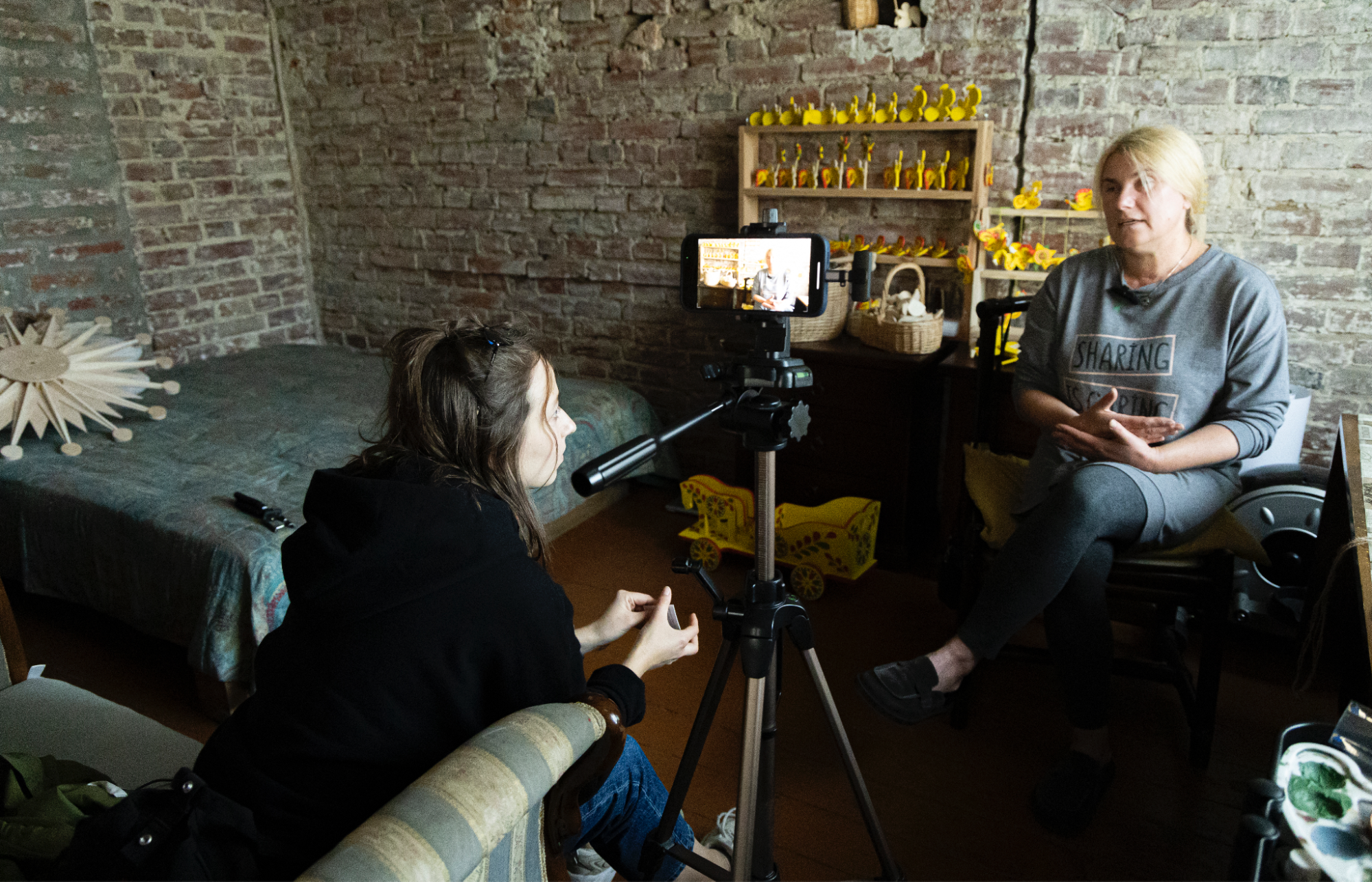
Oksana Kohut in her own workshop. Photo: Mykola Tymchenko for Rubryka
For 15 years, Kohut and Soika were able to make these toys and show them to other countries. Their main goal is to preserve and pass the tradition on to future generations. "People like us can only be born in 100 years, and the tradition must live on," the craftswoman shares.
Kohut is not the only one who hopes for the end of the war and a new rebirth — this is a common desire shared by all Ukrainians who feel a close bond with nature. Soon, the last leaves will fall from the trees in Roztochia, and everything in nature will be waiting for spring. However, somewhere deep in the trunks of majestic beech trees, life continues — and the circle of life touches humans as well, bringing hope that spring will finally come, and the meadows will bloom, the forests will turn green, and life will once again overflow with bright colors.
The project "Biosphere Reserves of Ukraine: Stories of War in Environmental Protection Institutions Creating a Green Future" was created with the support of UNESCO. The designations used, and the presentation of the material do not imply the expression of any opinion whatsoever on the part of UNESCO concerning the legal status of any country, territory, city, district, or its authorities or concerning the delimitation of its borders. The author is responsible for selecting and presenting the facts in this article and the opinions expressed therein, which are not necessarily the opinions of UNESCO and do not bind the Organization.

Ancient sheep farming and the river express to Hungary: Carpathian Biosphere Reserve during the war

Conservationists in captivity and "titans" of deciphering: how the Black Sea Biosphere Reserve lives during the war






